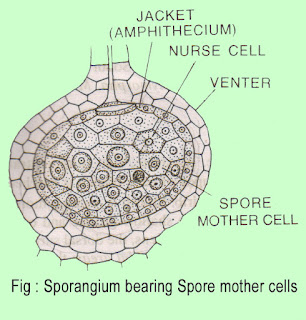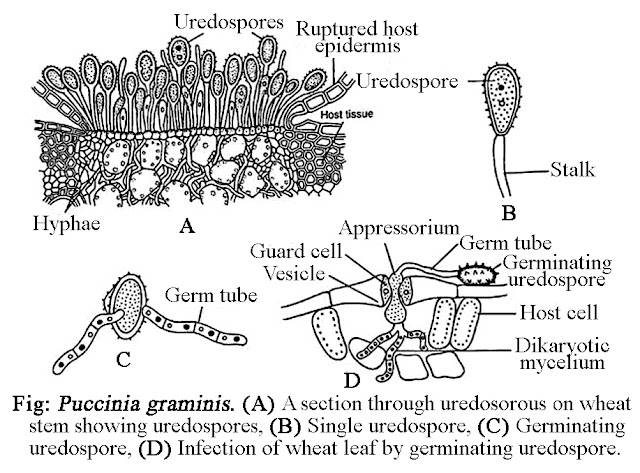RICCIA - CLASSIFICATION, STRUCTURE OF THE GAMETOPHYTE, REPRODUCTION, SPOROPHYTE
A. CLASSIFICATION
Division – Bryophyta
Class – Hepaticopsida
Order – Marchantiales
Family – Ricciaceae
Genus – Riccia
The genus Riccia comprises about 138 species which
are cosmopolitan and widely distributed both in tropical and temperate regions
of the earth. With the exception of a single aquatic species, R. fluitans, all the other species are
terrestrial.
About 28 species of Riccia have been reported from different
parts of India. Of these the common species are – R. discolor, R. crystalline, R. pathankotensis, R. melanospora, R.
forstii, R. gangetica, etc.
B. STRUCTURE OF THE GAMETOPHYTE
1. External structure:- The plant body of Riccia is flat, dorsiventral thallus,
which is prostrate, ribbon like and more or less fleshy. The branching of the
thallus is dichotomous. Due to repeated dichotomy and also due to the
occurrence of a number of such dichotomously branched plants together at a
place, the plants often take a rosette
form. The thallus is usually green
in colour and each thallus is provided with a midrib in the middle portion, which forms the apical notch at the tip.
The ventral (lower)
surface of the thallus bears numerous multicellular hairs or scales, and unicellular rhizoids of two types – smooth walled rhizoids and tuberculate rhizoids. Rhizoids attach
the thallus to the substratum and absorb water and solutes from the soil.
2. Internal structure:- Internally the thallus of Riccia shows tissue differentiation of various types –
(a)
Storage Region:-
The lower or ventral region in cross section shows colourless, compactly
arranged parenchymatous tissue without intercellular spaces. The cells of
parenchyma tissue generally lack chlorophyll and contain starch. Therefore, the ventral region primarily constitutes the
storage tissue. The lower portion of storage region is bounded by a single
layered epidermis, from which rhizoids of two types – smooth walled and tuberculate
arises.
(b)
Photosynthetic Region:-
The upper or dorsal region is composed of chloroplast bearing cells arranged in
vertical tiers. These tiers of cells are separated by narrow vertical air
chambers. Each air chamber is generally enclosed by four rows of cells. Each
air chamber communicates to the exterior by means of an air pore, which is a
simple intercellular space bounded by 4-6 epidermal cells. The terminal cell of
each chloroplast containing cells is colourless without pyrenoids and somewhat
enlarged and forms the upper epidermis of one celled thickness.
C. REPRODUCTION
The thallus of Riccia reproduces both by vegetative and
sexual process of reproduction –
1. Vegetative Reproduction:- Vegetative reproduction takes place by the
following process –
(a)
Fragmentation:-
It depends on the ageing of the vegetative cells. The cells in the older
portions die of old age and eventually disorganize. When the dead and decay of
the older portions of the thallus reaches the dichotomy, the young lobes become
separated. Each of these by apical growth grows into a new thallus.
(b)
Adventitious Branches:-
In R. fluitans special adventitious
branches arise from the ventral surface of the thallus in the midrib region.
They become detached from the parent thallus by the decay of the connecting
tissue and form a new plant.
(c)
Persistent Apices:-
In species growing in prolonged dry season, the whole plant die except the
growing apices. The persistent apices resume growth in the succeeding rainy
season.
(d)
Tuber Formation:-
It has been reported in R. perennis, R. discolor, R. vescata, and R.
billardieri. The apices of the thallus lobes become thickened to form
tubers at the end of the growing season. With the advent of unfavourable
conditions the plant dies. The tuber remains dormant and resumes growth under
suitable conditions.
2. Sexual Reproduction:-
Riccia is mainly homothallic (monoecious) i.e., same plant body bears both male (antheridia) and female (archegonia) sex organs. Some species
like R. discolor, R. frostii, etc. are heterothallic. In
monoecious species both archegonia and antheridia arise singly and each lies in
the floor of a separate cavity.
(a)
Antheredium:-
Each antheridium stands in a deep pit called antheridial chamber, and is attached to the thallus tissue my means
of multicellular stalk. The
antheridial chamber opens at the tip by a narrow pore called ostiole.
The antheridium is an
ovoid or pear shaped body enclosed by a single layer of sterile jacket layer known as antheridial
wall. Inside the jacket layer lies the numerous androcyte mother cells, metamorphose into two sperms or spermatids or androcytes.
(b)
Archegonium:-
Each archegonium also stands in a pit called archegonial chamber. The archegoniun is without stalk and is
directly attached with the thallus tissue.
The mature archegonium
is ahort stalked, flask-shaped and consist of venter and neck. The
venter consists of a ventral canal cell
and an egg cell. The neck is long and
consists of a row of four neck canal
cells. Each archegonium is bounded on the outer portion by a single layer
of jacket cells called archegonial wall.
D. FERTILIZATION
It takes place in presence of water. The sperms
after liberation from the antheridium swim in all directions on the film of
water, and some of them reach the archegonium. On reaching the archegonium, the
sperms make its way through the passage led by the dissolution of the neck
canal cell. On reaching the egg, one sperm fuses with the egg to complete the fertilization.
As
a result of fertilization, a diploid
zygote (2n) is formed. With the formation of zygote, diploid sporophytic
generation begins.
E. SPOROPHYTIC PHASE
Zygote is the first
cell of the sporophyte. Immediately after the formation, the zygote enlarges in
size until it nearly fills the cavity of the venter.
The zygote nucleus
first divide s transversely into two cells, each of which again divide
vertically to form 4-celled structure i.e.,
quadrant. Then another vertical division takes place so that 8-celled
structure i.e., octant is formed. The
cells of the octant divide and re-divide irregularly forming a spherical mass
of 20 – 410 cells. Then periclinal divisions take place which cut off an outer layer of cells, called the amphithecium and inner mass of cells, called the endothecium.
The amphithecium
first constitutes the jacket of capsule,
but later it serves as the nutrition of
the spores. The outermost layer constitutes the jacket of the mature sporophyte. The endothecium develops into sporogenous tissue. The sporogenous
tissue later develops into spore mother
cells. From each spore mother cell, by two successive divisions, one of
which is reduction division, four haploid
spores are produced. Some of the few cells of the sporogenous tissue
remains sterile, and are known as nurse
cells.
The mature sporophyte
is a globose capsule like structure without any foot and seta. It is simply a spore case. The spore case i.e., capsule
is provided with sterile jacket layer
of one-celled in thickness. Inside the jacket layer, lie the spore-tetrad and nurse cells. The spores are liberated after breaking the
surrounding tissue of the thallus.
After liberation, the
spore germinates under favourable condition by producing a germ tube to give
rise to new individual Riccia plant.
Prema Iswary,
Assistant Professor,
Department of Botany.
*************








This comment has been removed by the author.
ReplyDeletethank you it is simple and easy.
ReplyDeletesaugat thapa
nepal
+9779865407992 whatsapp please contact
Hi, this is very important for us.and help full. Please give me reply in mail
ReplyDeleteVery helpful
ReplyDeleteVery simple and brief description for the assignment 👌
ReplyDeleteVery easy description .. anyone can easily understand .. thank you mam
ReplyDelete